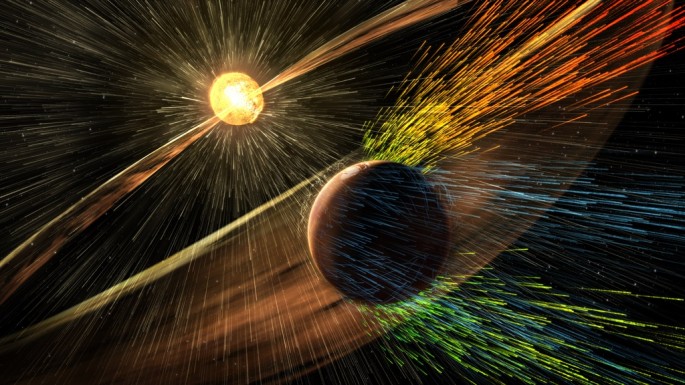New research shows how the sun disintegrated Mars' atmosphere as scientists documented a solar storm blasting away the thin Martian atmosphere, which is a crucial part of understanding how Mars became a cold, dry one from a once lush planet similar to Earth.
Since Mars does not possess a global magnetic field unlike Earth, the planet has no protection for its atmosphere from space radiation. This means that it is vulnerable and weak to solar ultraviolet radiation as high energies from gas and magnetic particles from the sun escape into space and shatter into the atmosphere during solar winds and solar storms.
Last March, NASA's Mars orbital probe known as MAVEN (Mars Atmosphere and Volatile Evolution Mission) captured a storm that appears to strip away the planet's tenuous atmosphere. This interplanetary coronal mass ejection also generated massive, dramatic spikes in oxygen and carbon dioxide ion levels that are streaming into space.
This storm from March is also the largest one recorded by MAVEN among half a dozen similar solar events that has been colliding into Mars since September 2014.
The focus of the mission is to study different types of radiation that are emitted by the sun and other cosmic sources to determine their impact on the Martian upper atmosphere. Along with this, this pivotal information can provide a clearer view of how Mars evolved from a warmer, wet world as NASA's Curiosity rover on the surface of Mars has already shown evidence that the planet possibly supported life.
Based on MAVEN data, scientists believe that there are two scenarios how this water disappeared, it's either it escaped into the atmosphere or all the water remains locked underneath the surface of the Red Planet.
According to lead investigator for MAVEN Bruce Jakosky from the University of Colorado, the single question which all have been trying to answer is, did Mars climate change? And did it get lost in space or by some other process? Since MAVEN data reveals how much gas already lost to space, this may hopefully answer if this had been an important process in Martian evolution.
This new study is published in the journal Science.



























